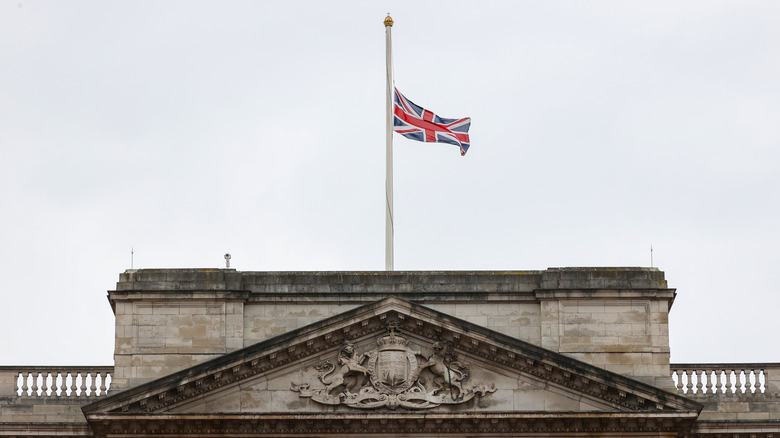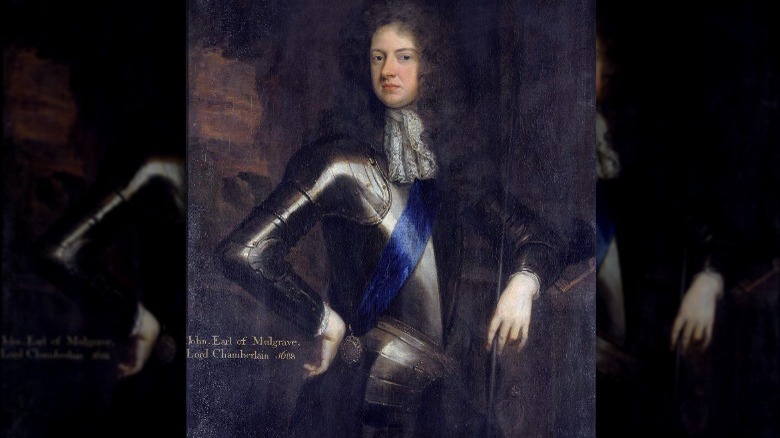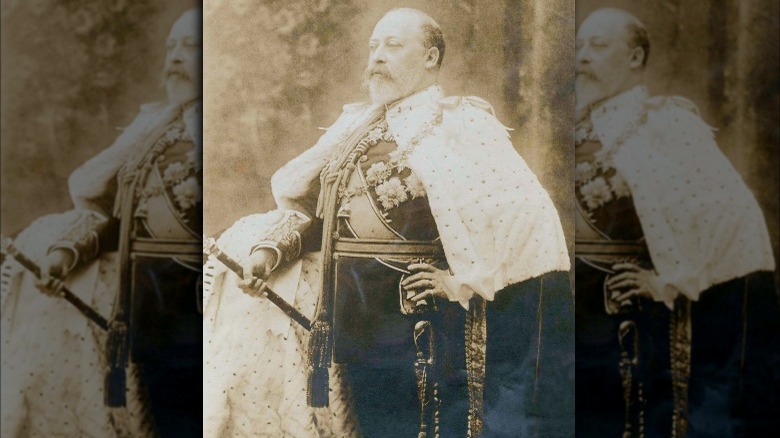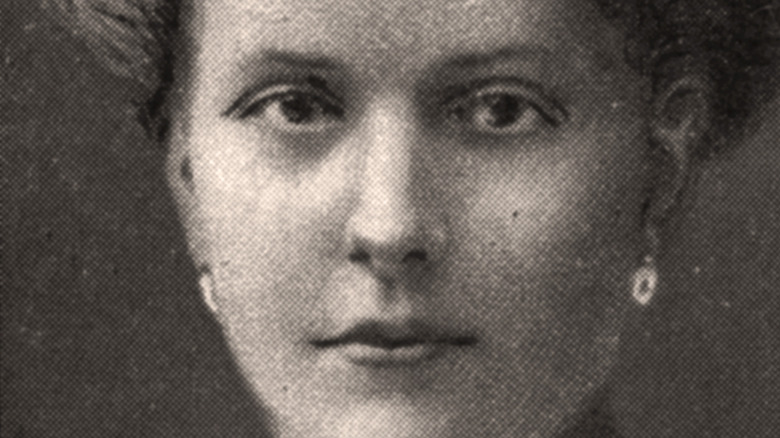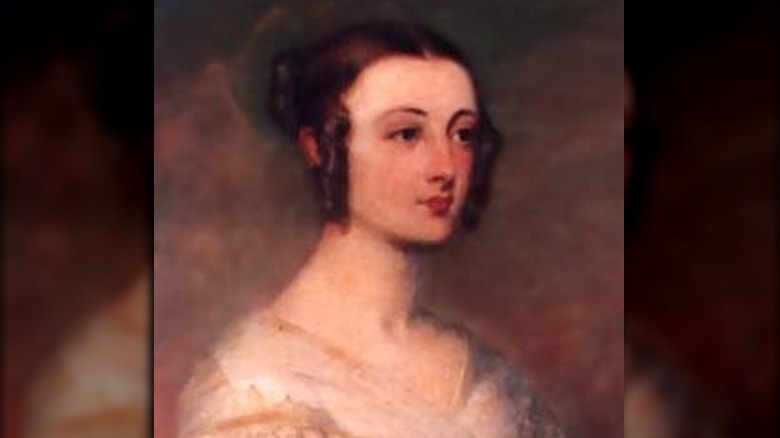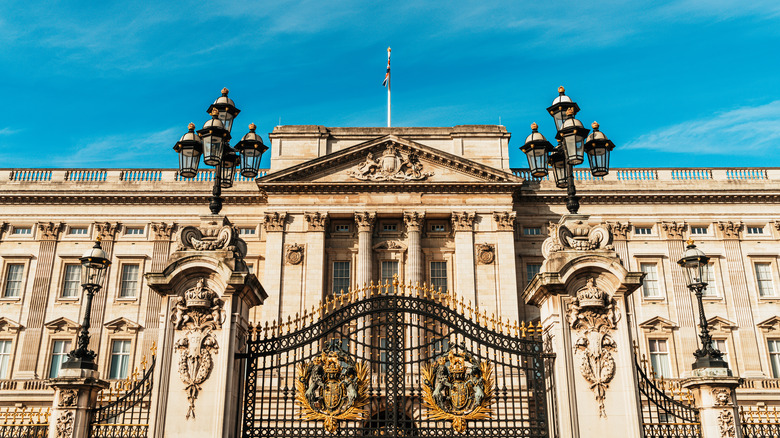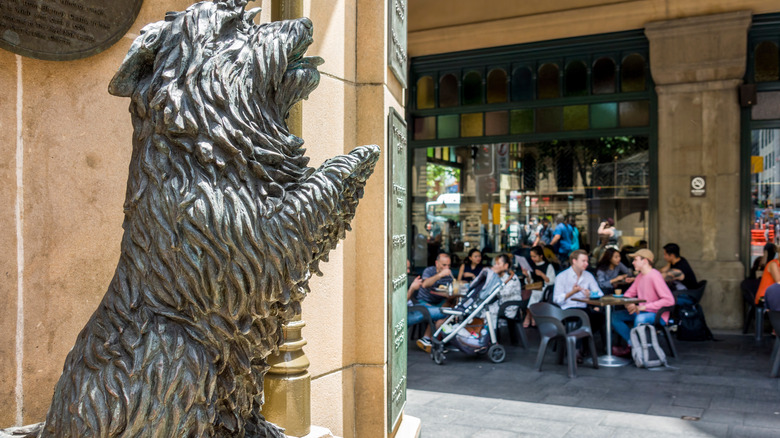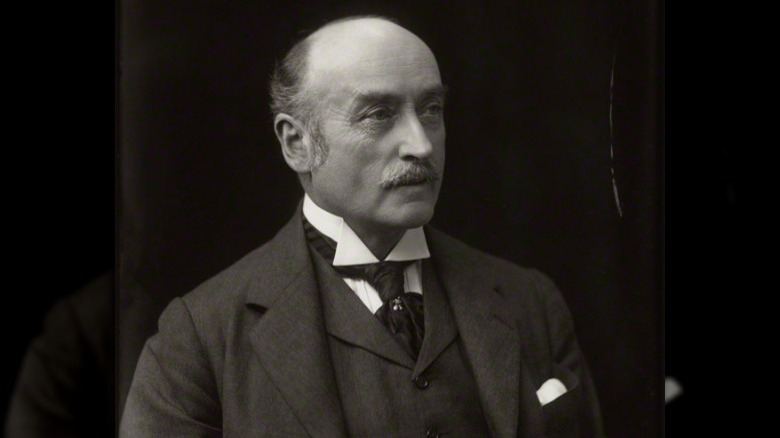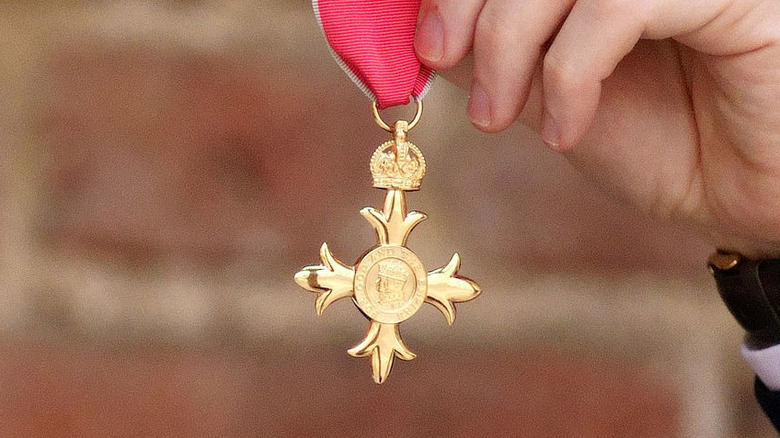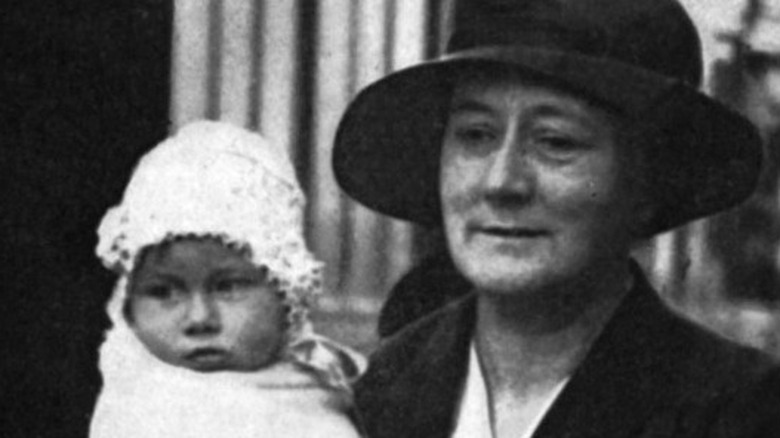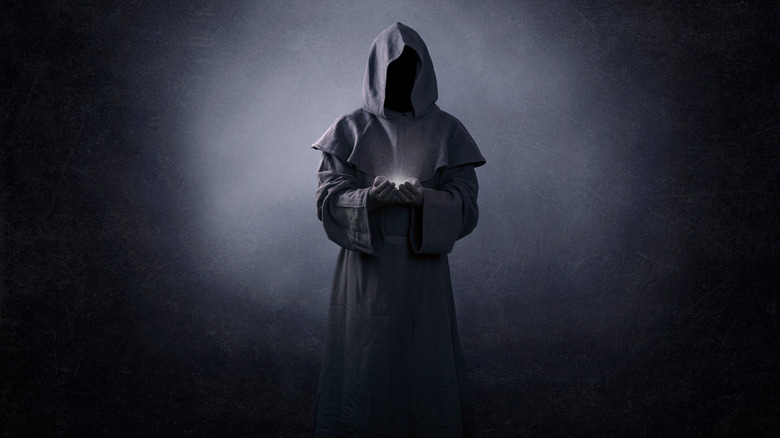The Only Deaths To Happen In Buckingham Palace
When a building has been around for a long time, there's a good chance someone is eventually going to die in it. And when it's 300 years old and has 775 rooms, including 188 staff bedrooms, well, that adds up to an awful lot of time, space, and opportunity for people to shuffle off this mortal coil.
Buckingham Palace has been around for a long time. The land itself has been British monarchy property for an excess of 400 years, but it has a history of occupancy that goes back even farther than that. At one point, the site was owned by monks, and at another time King James I dreamed of turning it into a silkworm farm.
The site didn't become associated with the name "Buckingham" until it was acquired by John Sheffield, the future first Duke of Buckingham. Sheffield razed the original structure in the early 1700s and built a new house later dubbed "Buckingham House." The palace we know today is an expansion and renovation of Sheffield's original structure. Over the years, royal families and their staff have moved in and out, rooms have been added, renovated, and furnished. Lots of babies have been born there, including Prince Charles, Prince Andrew, and Prince Edward. And a handful of people have also died there. Here are the only ones ... that we know of, anyway.
John Sheffield, first duke of Buckingham
The original owner of Buckingham House was also the first to die there. John Sheffield was a former military man who became a Knight of the Garter in 1674, then went on to become Lord Chamberlain and then, in 1703, the Duke of Buckingham and Normandy. He was also a poet. In fact, he had a bunch of enemies and that seems to be one of the reasons he turned to poetry — hey, when you can't eviscerate your enemies with a sword you might as well do it with words.
According to "The Queen's House: A Social History of Buckingham Palace," Sheffield loved Buckingham House and often wrote of his garden and a salon "filled with pictures, some good, but none disagreeable." He boasted about the view and the library and the birds outside his window, and seems to have become a bit bored with politics towards the end of his life, to the point where he really wasn't doing much beyond hanging out at home and writing letters about how awesome his house was. It's not super surprising that he ended up dying in Buckingham House at the age of 72, mostly because it seems like he wasn't too keen to ever leave.
Hugh Chamberlen the younger
Hugh Chamberlen the younger came from a long line of midwives. That's right, dudes can be midwives, too. In fact, according to the British Medical Journal, his family is believed to have invented obstetric forceps, though for whatever reason they took great pains to keep their invention a secret. Like, crazily secret to the point where they packed it into the birthing chamber in an oversized, gilded box, blindfolded the laboring woman, and then rang bells and made other mysterious noises in order to convince everyone outside the room that they were delivering the baby with some huge, complicated machine.
That was a few generations before Hugh the younger's time. Hugh was educated at Trinity College in Cambridge and became a doctor at the age of 25. The Chamberlen family never made money from their secret forceps (maybe because they were a secret?) and it was probably Hugh the younger who eventually told someone outside the family circle about their existence.
Hugh was well-respected and spent his later years hanging out with the Duchess of Buckingham, which is probably why he ended up dying in Buckingham House in 1728. According to the thrillingly named "Memoirs and Correspondence of Francis Atterbury: Volume II," Hugh had been suffering from an unknown illness for a long time, so it's likely he'd planned to die at Buckingham House in the presence of his friends the Duchess and her son, the younger Duke of Buckingham.
Edward VII
Edward VII was the second child of Queen Victoria and the great grandfather of Queen Elizabeth II. According to Express, Edward is the only British monarch who was born and also died inside the palace walls.
Edward reigned for just over a decade. Like his descendent Prince Charles, he was Prince of Wales for a very long time. His mother was in her 80s when she died, so he didn't become king until he was practically an old man. Despite his short reign, Edward was well-liked and even got the nickname "Peacemaker" because of his skill as a diplomat. His methods are a bit outdated today but worked well enough then — like more powerful monarchs before him, Edward used his familial bonds with European royalty to build stronger relationships between England and neighboring nations.
Edward was the last British monarch to use any of what little power he had. He worked on military reform and intervened during a constitutional crisis in the House of Lords. In 1910, he had a series of heart attacks but refused to rest, saying "No, I shall not give in; I shall go on; I shall work to the end." That's pretty much exactly what happened — he died just a few days later. Weirdly, his wife wouldn't let anyone touch his body and he stayed where he was for eight days until someone finally put him in a coffin and took him out of Buckingham Palace.
Princess Alice of Greece
Prince Philip's mother died at Buckingham palace just a couple of years after the royal family brought her out of Greece, where she'd spent time defying Nazis and taking care of sick people. Yes, Princess Alice had a much more colorful history than her own son, who is mostly known for things like playing squash during the birth of Prince Charles and just kind of existing. His mother, on the other hand, had a much more interesting (if not exactly happy) life. According to Oprah Daily, Alice was the great-granddaughter of Queen Victoria (Queen Elizabeth is similarly descended from Victoria, so take that how you want). She was also deaf, though her family gave her no special treatment. She was expected to do everything everyone else did, including learning how to speak three languages.
She married Prince Andrew of Greece and had five children, including Philip, who would later go on to become husband to the queen of England. The family fled Greece in 1917 for various political reasons and 13 years later Alice had a "nervous breakdown." She was committed to a Swiss sanitarium and briefly became a patient of Sigmund Freud.
Later in life, Alice moved back to Greece where she sheltered a Jewish family from the Nazis and founded an order of nuns. The British Royal family brought her back to England in 1967, and two years later she died in Buckingham Palace.
Flora Elizabeth Rawdon Hastings
Flora Elizabeth Hastings was born in Scotland in 1806. In 1834, she became a lady-in-waiting to the Duchess of Kent, who was also the mother of the future Queen Victoria. Flora was smart and witty and like so many other smart and witty women before and since, she was disliked by a lot of people.
According to Unofficial Royalty, Flora traveled by carriage to London after spending Christmas of 1838 in Scotland with her mother. Unfortunately, her carriage driver was a man and there was no one else traveling with them, which was pearl-clutchingly scandalous at the time. To make matters worse, Flora became ill not long afterwards, complaining of abdominal swelling, pain, and nausea. Because she had some enemies and because people in those days sucked almost as much as they do today, everyone around her figured she'd become pregnant during her trip to London. Even Queen Victoria jumped on the "Flora's pregnant" bandwagon.
Flora was finally examined by a doctor and declared to be a virgin, but her swollen abdomen was getting bigger, and a lot of people were still convinced she was pregnant. She endured months of ostracization until the summer of 1839, when it finally became obvious she wasn't pregnant, she was mortally ill. After her death in Buckingham Palace, an autopsy revealed that she had liver cancer. Queen Victoria, to her credit, was haunted by Flora's death and had nightmares about the dead girl for years afterwards.
John Gwynne
The life of a monarch is stressful, but the life of their staff is even more so, since staff are required to hold up all the same principles and values of their royal employers but without all the opulence and fancy meals. That kind of stress, unfortunately, is what drove Edward VII's private secretary, John Gwynne, to take his own life with a gunshot to the head. Details about Gwynne's death are scant — he's mostly just talked about in stories of famous British hauntings (staff say the room where he died feels creepy, and some claim to have heard a phantom gunshot).
In those days, divorce was becoming more common but was still viewed as shameful, especially by members of the royal family. Only a few decades later, Edward VIII was forced to abdicate his throne because he fell in love with an American divorcee, and the monarchy simply couldn't tolerate such things. John Gwynne was evidently unhappy in his marriage, or maybe it was just his wife who was unhappy, but either way the couple divorced. According to the Sunday Guardian, Gwynne couldn't endure the scandal and died by suicide in a Buckingham Palace office.
If you or someone you know is struggling with mental health, please contact the Crisis Text Line by texting HOME to 741741, call the National Alliance on Mental Illness helpline at 1-800-950-NAMI (6264), or visit the National Institute of Mental Health website.
Francis Clark
Even less is known about Highland Attendant Francis Clark, who is mostly remembered for a small bronze statue someone made of him in 1895 — a sort of Highland attendant action figure — various photographs, and a pair of dress studs bearing the photographs of two of Queen Victoria's dogs. According to the British Antique Dealers Association, the two studs were gifts from the queen, presented to Francis in 1874 as thanks for his service.
There's probably someone out there who knows exactly what a "Highland attendant is," but no one seems to have bothered to write it down. Based on the available information, a Highland attendant seems to be some sort of personal servant in a kilt. Francis appears in a few archived photos — in one, he's with four of the royal dogs. Evidently, at least some Highland attendant duties include walking the royal poochehighs.
Francis Clark joined Victoria's staff in 1870 and served for 25 years. Victoria gave him the Faithful Service Medal in 1891. He died in Buckingham Palace four years later, in the summer of 1895.
William Hayes Fisher
William Hayes Fisher was a Victorian-era politician who actually did a lot of different things throughout his reasonably long life (he died at the age of 67), but he's not really well-remembered because frankly, most of the stuff he did was boring.
According to the Peerage, Fisher was an Oxford University graduate, a lawyer, and later a member of parliament. He had a couple of jobs as a private secretary and he was the Junior Lord of the Treasury for seven years. Asleep yet? He was also the Government Whip of the House of Commons during the same time period, and he had a few other boring-sounding jobs with boring-sounding titles. A couple of years before he died, Fisher was created First Baron Downham, of Fulham, co. London, which is frankly the most interesting thing on the list so far. Oh and he was Knight of Grace, Most Venerable Order of the Hospital of St. John of Jerusalem, whatever that is. And chairman of an insurance company.
Notably, William Hayes Fisher died in the Buckingham Palace Gardens in July of 1920. For the uninitiated, the gardens at Buckingham Palace are about 40 acres of grass, trees, and shrubs featuring a lake, complete with a couple of islands and a waterfall. So while Fisher may have lived a boring life, at least he died in an interesting place. Good for him.
Eric Whitelaw
Because one Scotsman with a dog wasn't enough, here is another Scotsman with a dog who also died at Buckingham Palace. Frankly, Scotsmen with dogs really ought to steer clear of the queen's palace. Not much has been said about Eric Whitelaw except that he had a false arm, which he presumably got while serving during World War I with the Seaforth Highlanders. The Scottish Highlander Photo Archive has a photo of him smoking a pipe and holding a pair of white terriers. He's wearing a kilt and has a glove over his false hand.
Eric Whitelaw really doesn't seem like someone destined to die at Buckingham Palace, but that's what he did. In 1953 he was at the Palace awaiting an Order of the British Empire award. It wasn't for his military service, though (in case you were wondering), it was for his "services to the rubber industry in Ceylon." Oh-kay.
Anyway, Whitelaw never got the award because he died at the Palace before it could be bestowed on him.
Ilse Fairall
The only real record of this death that exists on the internet is in an old archived copy of the New York Times, published in 1978. According to the story, a palace servant took her own life on the eve of her retirement.
Ilse Fairall took her own life in her bedroom at Buckingham Palace. She was a 59-year-old widow who was just finishing her eighth year working in the palace laundry room. Details are pretty limited, but the story seems to suggest that she didn't really want to retire, so maybe her identity was so wrapped up in being a palace servant that she didn't see a future for herself as a retiree. Either way, this is one of the more tragic of the Buckingham palace deaths. Fairall left a suicide note and a will in the room where she died, but the details don't seem to have ever made it into the newspapers.
If you or someone you know is struggling with mental health, please contact the Crisis Text Line by texting HOME to 741741, call the National Alliance on Mental Illness helpline at 1-800-950-NAMI (6264), or visit the National Institute of Mental Health website.
Margaret MacDonald
Nicknamed "Bobo," Margaret MacDonald served Queen Elizabeth II for 67 years, starting when the queen was a baby and ending when MacDonald died in 1993 at the age of 89. MacDonald and the queen were close. According to AP News, they slept in the same room until Elizabeth was 11 years old. In fact, MacDonald got her nickname from the queen herself — supposedly, "Bobo" was Elizabeth's first word.
MacDonald continued to faithfully serve the queen during all of her travels and life milestones, and as a reward the Queen made her a Lieutenant of the Royal Victorian Order. Late in life, MacDonald's job was basically just the official friend to the queen. She got a private room in Buckingham Palace and was not really expected to do anything except be the queen's confidante.
She died in her sleep in her room at Buckingham Palace. No cause of death was ever made public, but it's probably safe to say that old age had something to do with it.
The last royal corgi
If you're a fan of "The Crown," then you have no doubt noticed that there is a Welsh corgi in every other scene. If you're not a fan of the crown (or the royal family in particular), a Welsh corgi is a medium-sized dog with a foxlike face and stubby legs, and Queen Elizabeth II has owned them since she got her first one at the age of 18. Since then, the royal corgis have been reproducing almost as fast as the royal family. But according to NPR, the line came to an end in 2018 with the death of Willow, the very last of the royal line of Queen Elizabeth II's corgis.
Corgis are not people, obviously, which is why this list doesn't include every single dog who ever died at Buckingham Palace even though there are almost certainly more than just one of them. But the death of this particular dog is significant because it represents the end of an era. It's even a little foreshadow-y — this line of Corgis has been around for the queen's entire reign, and now that it's come to an end, well, let's just say there are changes in the wind.
A monk (maybe)
This one is a bit of a stretch, but it deserves to be included because this person, hundreds of years after his death, still will not allow himself to be forgotten. Not that anyone really knows who he is or anything.
According to MyLondon, long, long before Buckingham Palace was Buckingham Palace there was a monastery on the site. In fact, it was pretty close to the spot where the queen's back terrace is today. Supposedly, the ghost of one of the monastery's former residents still wanders around nearby. And because a creepy ghost in a creepy brown robe isn't creepy enough all by itself, he's rattling chains and moaning, too, which means he's either a super fan of Dickens' "A Christmas Carol" or he did some misbehaving back when he was alive. One popular story says he was locked up and starved to death, which explains why he's still roaming the grounds.
Writer John Pullen says the monk only appears on Christmas Day, which further supports the theory that he's a Dickens superfan. Fortunately, the queen tends to spend her holidays elsewhere, so it's probably unlikely he's ever managed to show her all her ghosts of Christmas past.
